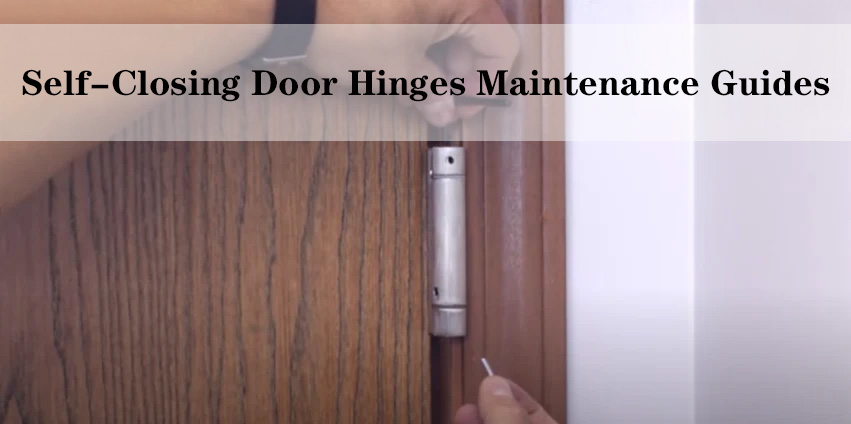When it comes to home improvement, door hinges are often overlooked, yet they are fundamental in ensuring that doors function smoothly and reliably. For DIY enthusiasts or homeowners looking to enhance their living space, mastering the installation of door hinges is a valuable skill. This skill not only adds to your DIY repertoire but also saves costs on professional installation. In this guide, we will cover various types of hinges, from the common ones used in interior doors to the specialized self-closing models, guiding you through each step to transform you from a novice to a pro in hinge installation.
Understanding Door Hinges
Before you start the installation process, it’s crucial to have a clear understanding of the types of hinges and their specific uses. Here’s a deeper look into some common types:
Butt Hinges: These are the most common type of hinges used in homes. They consist of two plates, known as leaves, joined by a pin. Butt hinges are ideal for most interior doors, as they provide a clean, traditional look and are easy to install. They come in various sizes, and selecting the right size depends on the door’s weight and width.
Continuous Hinges: Also known as piano hinges, these run the entire length of the door and are excellent for adding stability to longer doors or ones that require additional support. They are often used on heavy-duty doors or where alignment is critical, such as in storage or utility cabinets.
Pivot Hinges: These hinges are mounted at the top and bottom of the door, allowing it to pivot open and closed. They are perfect for modern, contemporary doors or when you want a hinge that is almost invisible. Pivot hinges provide a sleek look and are often used in custom cabinetry or high-end home designs.
Self-Closing Hinges: These are particularly useful for doors that you want to remain closed after opening, such as gates, or kitchen and bathroom cabinets. They use a spring mechanism to automatically close the door, which is ideal for child safety or maintaining privacy.
Tools You’ll Need
- Screwdriver (or a drill with screwdriver bits)
- Chisel
- Hammer
- Tape measure
- Carpenter’s pencil
- Level
- Hinges (and screws usually included with them)
Step-by-Step Guide to Installing Door Hinges

When choosing hinges, consider not just the door’s size and weight, but also the aesthetic and functional aspects. For instance, in a minimalist designed home, a less visible hinge type might be preferable. Similarly, for exterior doors that require added security, heavy-duty hinges would be more appropriate.
Installing door hinges can be a straightforward process when you follow these steps. Here, we focus on the general approach, applicable to most types of hinges, including butt hinges, which are commonly used in residential settings.
1. Measuring and Marking:
Accuracy Is Key: Begin by using a reliable tape measure to determine where your hinges should be placed. Remember, even a small error in measurement can lead to a poorly fitting door.
Standard Placement: The general rule for standard doors is to place the top hinge 5 inches from the top and the bottom hinge 10 inches from the bottom. For doors over 5 feet in height, consider adding a middle hinge for extra support.
Marking the Spot: With your measurements in hand, use a carpenter’s pencil to mark the spots on both the door and the door frame. These marks are your guides for the next steps, so ensure they are visible and accurate.

2. Outlining the Hinge:
Precision Tracing: Position the hinge on your marks, ensuring it is perfectly aligned. Using your pencil, trace around the hinge. This outline should be precise, as it dictates the size of the cutout (mortise) you will make.
Repeat for Accuracy: Repeat this process for each hinge on both the door and the frame. Consistency in placement ensures the door hangs evenly.
3. Chiseling Out the Mortise:
The Right Tools: Ensure your chisel is sharp for a clean cut. A dull chisel can cause uneven edges and make the installation more difficult.
Creating the Mortise: Gently tap the chisel with a hammer within the traced outline, cutting along the pencil lines first to establish clean borders. Then, chisel out the inner area. The goal is to create a recess that allows the hinge to sit flush with the wood surface.
Depth Matters: Check the depth frequently. A too-deep mortise can make the hinge loose, while a shallow one won’t allow the door to close properly.
4. Attaching the Hinge:
Positioning the Hinge: Place the hinge into the mortise, ensuring it fits snugly.
Pre-drilling Holes: Mark the screw holes with your pencil. Pre-drilling these holes is crucial to prevent wood splitting and to make the actual screwing easier. Use a drill bit slightly smaller than your screws for this task.
Securing the Hinge: Align the hinge and screw it in place, starting with the middle screw to hold the hinge steady as you add the others.
5. Hanging the Door:
Lining Up: Carefully align the hinges with the corresponding mortises on the door frame. This step may require assistance, as holding the door steady is key.
Securing the Door: Screw the hinges into the frame, starting from the top hinge. Ensure each screw is tight for a secure fit.
Checking Alignment: Make sure the door is level. An unlevel door can lead to improper closing or even damage over time.
6. Fine-Tuning:
Test and Observe: Open and close the door several times, observing its movement. It should swing smoothly without any scraping or sticking.
Making Adjustments: If the door isn’t closing properly, slightly loosen the screws and adjust the position of the hinge. Sometimes minor shifts can significantly improve the door’s functionality.
Final Check: Once adjusted, give the door a final test. Ensure it opens and closes smoothly and latches securely.
Tips for a Successful Installation
Double-Check Measurements: This cannot be overstressed. Even a small error in measurement can lead to doors that don’t fit properly. Use a reliable tape measure, and always measure twice before cutting or drilling. Remember the old carpentry adage, “Measure twice, cut once.”
Using Existing Cutouts as a Guide: If you’re replacing old hinges, the existing cutouts on the door and frame can be incredibly helpful. They provide a template for where the new hinges should go, reducing the amount of measuring and cutting required. However, ensure the new hinges are of similar size or shape to the old ones for this tip to be effective.
Extra Support for Heavy Doors: Heavier doors, like solid wood exterior doors, can strain and eventually warp standard hinges. Using a third hinge distributes the weight more evenly, reducing strain on the individual hinges and ensuring smoother operation. Place the third hinge equidistant between the top and bottom hinges for optimal support.

Safety First with Tools: Safety should always be a priority when working with tools. Wear safety goggles to protect your eyes from wood chips or metal shavings. If you’re using power tools, ear protection is also a good idea. Keep your work area clean and free of clutter to avoid accidents.
Conclusion
Installing door hinges, while straightforward, is a task that has a significant impact on your home. Properly installed hinges mean doors that function smoothly and look great. By following the steps laid out in this guide, and especially by adhering to the tips for success, you’re not just installing hardware – you’re enhancing your home.
Remember, patience and precision are your best tools in any DIY project. Take your time to understand the process, prepare your materials, and execute each step carefully. The satisfaction of seeing your doors swing smoothly and close perfectly is well worth the effort.
And finally, DIY projects are also about learning and having fun. Don’t be discouraged by minor setbacks. Each challenge is an opportunity to grow your skills. So, gear up, measure carefully, and get ready to transform your doors into functional art. Happy DIY-ing!























